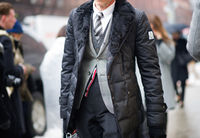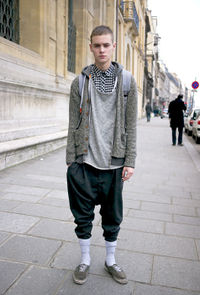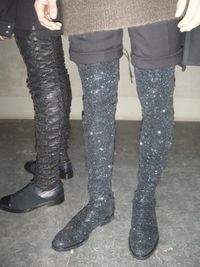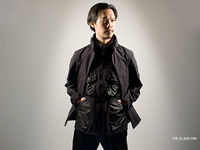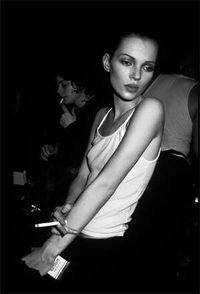Difference between revisions of "Styles"
(→Urban Techwear) |
(→Heroin Chic) |
||
| Line 88: | Line 88: | ||
==Heroin Chic== | ==Heroin Chic== | ||
[[File:chic.jpg|200px|thumb|right]] | [[File:chic.jpg|200px|thumb|right]] | ||
| − | '''Examples of Brands: [[Yves Saint Laurent Rive Gauche]] (Hedi Era), [[Dior Homme]] (Hedi Era), [[Saint Laurent Paris]] ( | + | '''Examples of Brands: [[Yves Saint Laurent Rive Gauche]] (Hedi Era), [[Dior Homme]] (Hedi Era), [[Saint Laurent Paris]] (also Hedi Era) |
Heroin chic became popular in the 90's. Starting with Calvin Klein's campaign for his Calvin Klein collection runway fashion line featuring Kate Moss, and Vincent Gallo shooting emaciated, drug-addicted looking models, it was quickly devoured as the hottest style. Heroin prices were dropping and the purity was much better at the time, which helped increase it's popularity. | Heroin chic became popular in the 90's. Starting with Calvin Klein's campaign for his Calvin Klein collection runway fashion line featuring Kate Moss, and Vincent Gallo shooting emaciated, drug-addicted looking models, it was quickly devoured as the hottest style. Heroin prices were dropping and the purity was much better at the time, which helped increase it's popularity. | ||
| − | The style was dead in the magazines when | + | The style was dead in the magazines when, Gisele Bundchen was dubbed the new supermodel in 1999. Nowadays, though, it carries on in fashion with a much lighter tone thanks to our teenagers who insist on dying due to anorexia which, as a result, places Heroin Chic in poor light. |
<br /> | <br /> | ||
Revision as of 01:21, 11 June 2013
--Any information on a certain style goes here. The history of a style is also welcome. For more trendy or conceptual stuff, see Trends (bottom)
Contents
A Small Note on Styles
If you haven't read the Introduction, then do it now. This page is for different styles, not only in fashion, but also in the life you lead. Many people disregard their day-to-day life when attempting a new style, and this is where they fail. Be concise when looking for your ideal style. Don't be a try-hard, don't be an actor.
Please Note: Categorizing fashion into "styles" like they were animals in a taxonomy, while convenient for the beginner, is actually a terrible view to adopt. Outfits cannot be "categorized" into styles completely because each one is unique, and many deviate from these supposed "styles". Styles are not objective. For more information on developing your personal style, see "Taste" in Introduction.
Traditional
Examples of Brands: Thom Browne, Tom Ford, Isaia, Brioni, Ralph Lauren Purple Label, Martin Greenfield, Calvin Klein Collection
Menswear is a modernized style that draws from conservative or classical male working aesthetic. Masculine silhouettes, formal incorporated into casual attire, and somewhat preppy styles fall here. Fit and fabric serve great importance in menswear outfits, as well as in controlling the quality of the clothing you purchase. Cheaply made, ill fitting menswear is a recipe for disaster, as it is very easy to come off as sloppy or trashy. Keeping this in mind, a crisp tailored button-down, slim-fitting trousers, a pair of casual oxfords, and a relatively casual tie, for example, can be worn to either a job interview or a night out.
In the debates that take place on /fa/ and elsewhere, styles are often given names by their opponents to mock and ridicule its followers. The derogatory term used to describe menswear is "dadcore". As the style's classical aesthetic is associated with the older generations (as in being "clothes for dads") menswear has been mocked as such. However, the nickname has since turned into the term used for failed attempts at menswear which include fedoras, ill fitted suits and generally horrid taste.
Clothing in this type of style highly emphasizes construction, material quality and the difficult pattern-making work. Such examples include Loro Piana who is known for cashmere, Ermenegildo Zegna for their wool, and bespoke labels.
Streetwear
Examples of Brands: Supreme, White Mountaineering, A Bathing Ape, Undercover, WTAPS, Visvim
Streetwear is usually regarded as the most flexible style on /fa/, with so many possibilities that nearly anything can be called streetwear. Streetwear is mostly personal preference and has many forms, ranging from your typical snapback-wearing adorned "swaggot" (one obsessed with the concept of swag) to Japanese workwear. Two good sites dedicated to streetwear are Hypebeast and superfuture.
Streetwear can be described as practical for everyday wear and even light, physical activities. The general rule of thumb is that it cannot contain easily spoiled pieces.
Examples Gallery
Artisanal/Avant-Garde
Examples of Brands: Rick Owens, Yohji Yamamoto, Julius_7, Ann Demeulemeester, Maison Martin Margiela, Rad Hourani.
Artisanal styles are a much less accessible, niche aesthetic. The style is humorously referred to as "goth-ninja" (taken from a misguided young woman in the summer of 2007 who made a blog post about her new found love of a Rick Owens show titled "Crust" ) by those who oppose it, although this should not be mistaken for the appropriate term. The usual defining features of this style are gray-scale color palette, unconventional proportions, and fragile knits meant to tear and conform to the wearer's body -- but really, anything goes.
Common artisanal fads in the past were minimalism (late 90's), deconstruction (early-mid 00's), and now womenswear designs applied to menswear pieces (Rick Owens pioneered this with skirt jeans, heels and a unisex shoulder strap tank top).
Many pieces are made with unique techniques, treatments, and materials. A vast majority of "artisanal" brands place a strong priority on being anti-branding, using minimalist logos on the interior of pieces, generally placing priority on the construction, form, and quality of the garment above the branding.
Many of the people who appreciate this aesthetic share the same appreciation for craftsmanship and modern design.
Urban Techwear
Examples of Brands: Acronym, Arc'teryx Veilance, Y-3, Gyakusou, Isaora, Outlier
Clothing designed for a specific purpose, but worn as everyday clothing. Many brands in this sort of aesthetic are the results of collaborations between fashion designers and sportswear brands (e.g., Y-3, Gyakusou).
Much of the clothing adhere to a military inspired look (started with Christopher Bailey's reintroduction of the military inspired aesthetic).
Combines clothing with a streamlined, technical look. Derives from common streetwear, but with a twist that focuses on human interaction with the elements through technology. Smart fabrics, digital gadgets and the like are coupled with the clothes themselves making many fit for outdoor activities as well.
Examples Gallery
Heroin Chic
Examples of Brands: Yves Saint Laurent Rive Gauche (Hedi Era), Dior Homme (Hedi Era), Saint Laurent Paris (also Hedi Era)
Heroin chic became popular in the 90's. Starting with Calvin Klein's campaign for his Calvin Klein collection runway fashion line featuring Kate Moss, and Vincent Gallo shooting emaciated, drug-addicted looking models, it was quickly devoured as the hottest style. Heroin prices were dropping and the purity was much better at the time, which helped increase it's popularity. The style was dead in the magazines when, Gisele Bundchen was dubbed the new supermodel in 1999. Nowadays, though, it carries on in fashion with a much lighter tone thanks to our teenagers who insist on dying due to anorexia which, as a result, places Heroin Chic in poor light.
